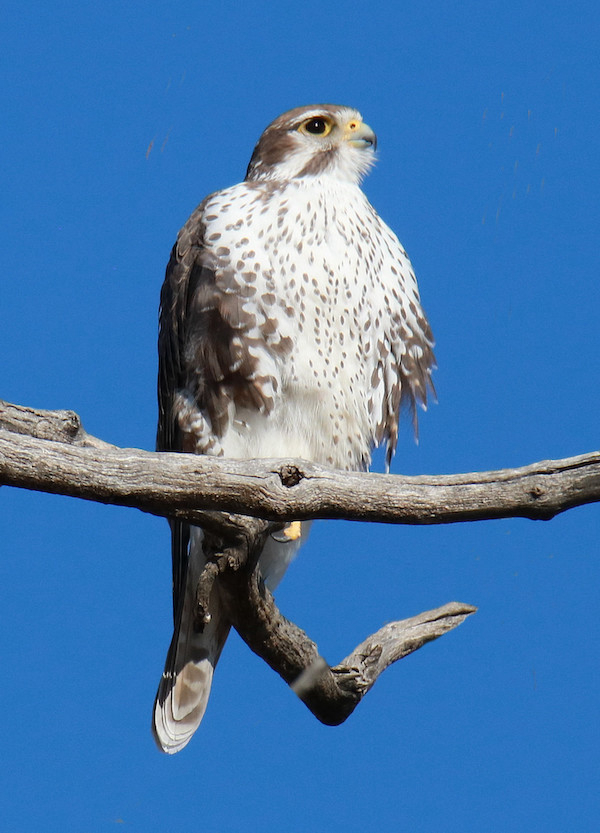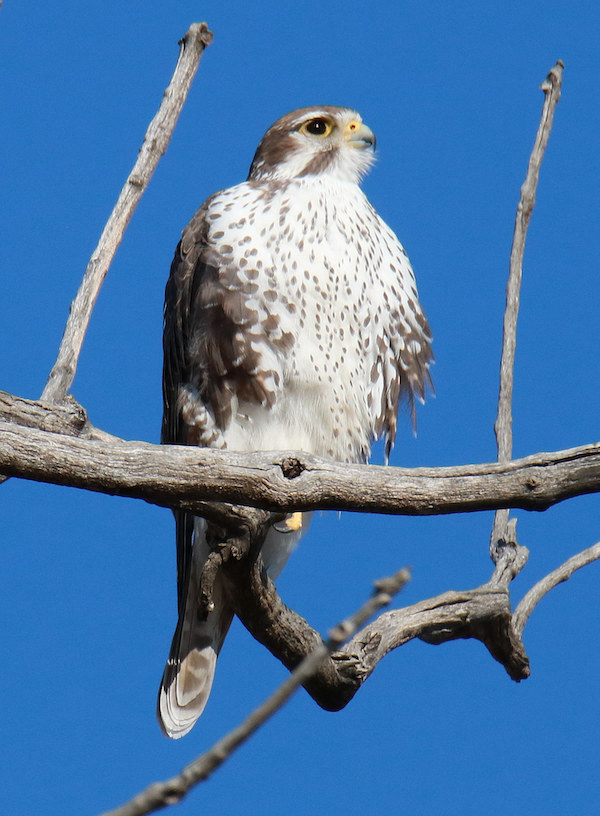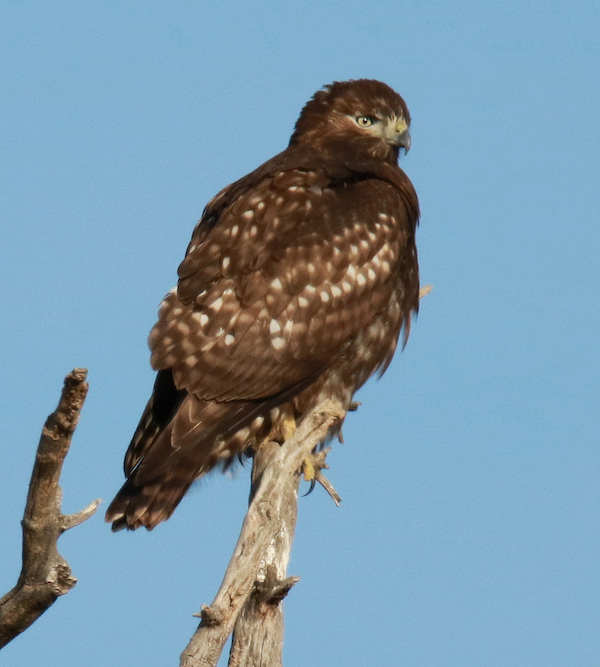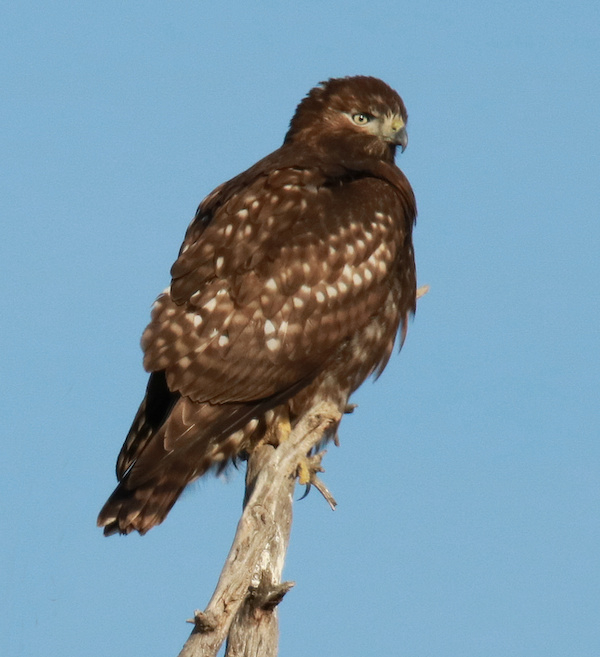
To create a pleasing image of this large female Prairie Falcon, it took a new photo editing effort to “erase” some surrounding twigs and branches.
|
As described in this week’s Editor Afield article, I had an active day afield during my initial visit to my SoDak winter raptor hotspot, and although the percentage of raptors that provided good photo opportunities was very low, the birds that provided photo ops were excellent subjects. I photographed 4 of the 34 raptors I counted along my transect that’s punctuated by the South Dakota capitol of Pierre as the center point.
Realistically, only 2 of the 4 birds of prey I photographed were encountered under optimum conditions – a huge female Prairie Falcon, and a dark morph Harlan’s Red-tailed Hawk. Unfortunately, the other 2 raptors – a beautiful adult male Golden Eagle and another dark morph Harlan’s Red-tailed Hawk – were photographed during very low light conditions. The eagle was present only when a rogue cloud blocked the sunlight, and the hawk materialized as the sun was so low in the sky that the light actually had an orange tinge to it. Plus, both of these birds were perched on the crossbars of wooden power poles, not the kind of perches I prefer over natural perches.
Even so, the Prairie Falcon and first Harlan’s Red-tail were perched in perfect sunlight in locations where I could position my mobile blind for the best possible photo angles. The Prairie Falcon literally beamed reflected light off its white plumage and was as trusting as I could hope for as it perched high in a sentinel cottonwood tree, on the lookout, on the hunt. As I took a couple initial photos I marveled at this dynamic falcon, but I reflected about how the image would be much better without the distracting twigs and branches in close proximity. But even then, I thought that the resulting photos would force the issue of trying to eliminate the distracting branches in the darkroom – something I have never tried before.
Digital Darkroom

In the original photo, above, the Prairie Falcon and sky were attractive, but they were overshadowed by distracting twigs and branches – enter the “Cloning Brush.”
|
Back in my office, after selecting the best photo of the big Prairie Falcon, I used my preferred computer-based photo editing software to make my usual simple crop of the image. When cropping, I try to balance the image just right, side to side and top to bottom, while leaving some blue sky space around the bird. But there were still those distracting branches to contend with. I thought that I must be able to “erase” the twigs on each side of the falcon, but I had never tried to do that before, so searched for my handbook for my Paintshop Pro photo editing software.
After a quick look without luck, I returned to my computer screen and searched down Paintshop Pro’s line-up of photo editing “tools.” Toward the end of the icons I found a tool named “Clone Brush” – that’s gotta be it. At that point I figured: Directions, who needs ‘em, and jumped right into “cloning.” I positioned my cursor on the first twig and left-clicked my computer mouse as usual, which prompted a message box to pop up that said “Right click to select source.” OK, so I right clicked on the sky next to the first twig, then moved over to the twig and began “erasing” the twig using the cloned sky blue color to replace the gray-brown twig. I was amazed! It worked just that easily and so impressively. In less than a minute the twig was gone, replaced by perfectly uniform blue sky color without a hint of variation between the existing sky and the cloned sky. Amazing!
Next twig: I positioned my cursor on the blue sky next to the twig, right-clicked, and started erasing the twig every bit as easily as the first. Hooray! What a difference that 2-minute effort made in the photo by “removing” the 2 vertical twigs. Now I looked below the horizontal branch and decided there were some extraneous twigs that could be removed there too. Just as simply, I went to work removing those twigs, and I even shortened one of the branches to make it a bit more palatable. Overall effect: Remarkable!

The cropped photo of the dark morph Harlan’s Red-tailed Hawk had an alien snag in the lower left corner (above), which was not overly concerning, but it was similarly “erased” as an improvement for the resulting photo (below).
|
As I was using the Cloning Brush, I learned a couple simple things to watch for as you are cloning. First, you need start with a uniform background color, and in my case the sky provided in the best possible way. Second, be aware that the initial right-click “clone source” moves as you erase. It’s best to select the clone color 1/8-inch or so away, then erase in a direction so your initial clone circle stays within the desired color. I realized this after I moved the sample circle across a twig, which transferred the twig’s colors instead of the blue sky color. Therefore, it may require you to use a couple clone color locations as you work your way along a twig, branch, or whatever you are erasing. (The above description is hard to provide in writing, and probably hard to follow, but the points described will become evident when you use the Cloning Brush.)
All of this proved to be remarkably simple, it took only a very few minutes, and improved the photo in a remarkable way. Try it, you will be similarly impressed with the ease of photo editing in this way, and with the excellent results it provides. As for the computer software I mentioned above, I prefer to use PaintShop Pro for photo editing for its simplicity and its low cost, as compared to a popular software that is expensive, requires an annual payment, and is not as easy to use. You can get a 30-day Free trial of the New 2022 version, or buy it outright with a 40 percent savings on an already low price (less than $40) at Powerful, New Photo Editing Software – Try PaintShop Pro 2022
Black Hawk Clone

A classic portrait of a dark morph Harlan’s Red-tailed Hawk was improved a bit using the Clone Brush to remove a snag from the lower left side of the image. The change was easy and quick using photo editing software.
|
After having such easy and impressive results with the Prairie Falcon photo, after cropping the photo of the dark morph Harlan’s Red-tailed Hawk I noticed an unnecessary branch in the lower left corner of the image and figured, let’s give this a try too. I used the same actions described above to replace the branch with clear blue sky, and yes, it made a big difference with less than a minute of effort – pretty slick! I would dare to say that by now I was a convert, and I started thinking about other photos in my files that could benefit from this quick and easy editing process.
As you may remember, I’m not big on doing much photo editing and usually limit my editing to a simple crop of extraneous surrounding sky or landscape. Even when I tried to alter a photo by replacing the background in a photo earlier this year, it took way too long and the results were good but not great. In this case of trying a simple cloning edit, I’m sold on the way it improved the image without distorting anything in the image. I’m pretty thrilled with the process and especially happy with the results, so I offer my before and after photos for your consideration, and perhaps you will find a way to use this technique on existing or future photographs.
In the meantime, enjoy your Thanksgiving holiday and make it a point to seek out some new bird photo opportunities at a favorite birding site, a new location, or even in your yard or neighborhood to enhance a Happy Thanksgiving weekend.
Article and photographs by Paul Konrad
Share your bird photos and birding experiences at editorstbw2@gmail.com